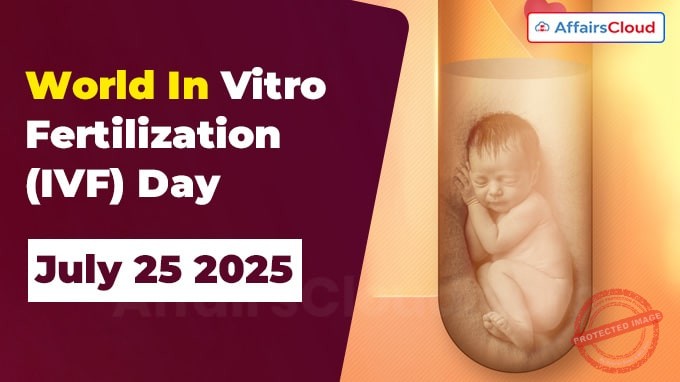 World In Vitro Fertilization (IVF) Day, also known as World Embryologist Day, is annually observed across the globe on 25th July to raise awareness about IVF technology, and its role in addressing infertility using assisted reproductive technology (ART).
World In Vitro Fertilization (IVF) Day, also known as World Embryologist Day, is annually observed across the globe on 25th July to raise awareness about IVF technology, and its role in addressing infertility using assisted reproductive technology (ART).
- The day commemorates the birth of Louise Brown, the world’s first baby conceived through IVF technology in 1978.
About World In Vitro Fertilization (IVF) Day:
Background: The world’s first successful birth through IVF was accomplished in the United Kingdom (UK) due to the pioneering efforts of Dr. Patrick Christopher Steptoe, Dr. Robert Geoffrey Edwards, and nurse Jean Marian Purdy.
Milestone Birth: Louise Brown, born on 25th July 1978 at Dr. Kershaw’s Cottage Hospital in the UK, became the first child born using IVF technology, after her mother, Leslie Brown, had undergone more than 100 unsuccessful embryo transfer attempts.
Recognition: Dr. Robert Edwards, regarded as the “Father of IVF,” was awarded the Nobel Prize in Physiology or Medicine in 2010 for his contribution to the development of IVF.
About In Vitro Fertilization (IVF):
What is IVF? It is a procedure under Assisted Reproductive Technology (ART) in which an egg is fertilized by sperm outside the human body in a laboratory, involving steps like ovarian stimulation, egg retrieval, fertilization, embryo culture, and embryo transfer.
Purpose: IVF is used to treat infertility in individuals or couples facing conditions such as blocked or damaged fallopian tubes, male infertility (low sperm count), age-related fertility issues, unexplained infertility, or genetic disorders, offering a medical solution for those unable to conceive naturally.
About Assisted Reproductive Technology (ART):
Overview: ART includes medical procedures that help treat infertility by handling eggs, sperm, or embryos outside the body, followed by their transfer into the uterus to support pregnancy.
Types: Common types of ART are IVF, Intracytoplasmic Sperm Injection (ICSI), Intrauterine Insemination (IUI), Artificial Insemination (AI), and Frozen Embryo Transfer (FET); these may also involve techniques like embryo freezing, genetic testing, and surrogacy.
Regulations of ART in India:
Legal Framework: The Assisted Reproductive Technology (Regulation) Act, 2021 was passed on 20th December 2021 to regulate ART services in India.
- It ensures ethical practices, protects patient rights, and sets standards for ART clinics and banks.
Registration: Only registered ART clinics and banks are allowed to operate under the Act.
Restrictions : It prohibits sex selection and safeguards the identity and rights of donors and ART-born children.
Rules and Regulations: The Ministry of Health and Family Welfare (MoHFW) notified ART Rules in 2022 and ART Regulations in 2023. These aim to enhance medical care, transparency, and safety for patients and donors.
Guidelines: The Indian Council of Medical Research (ICMR) and National Academy of Medical Sciences (NAMS) issued national ART guidelines.
- Surrogacy is regulated separately under the Surrogacy (Regulation) Act, 2021.
First Indian Test Tube Baby:
First IVF Baby: Kanupriya Agarwal, also known as Durga, was born on 3rd October 1978 in Kolkata, West Bengal (WB), and is recognised as India’s first IVF baby and the world’s second.
- She was conceived through IVF by Late Dr. Subhas Mukherjee, making India the second country after the United Kingdom (UK) to achieve an IVF birth.
First Scientifically Documented IVF Baby: Harsha, the first scientifically verified IVF baby in India, was born on 6th August 1986 in Mumbai, Maharashtra.
- It was achieved through the collaborative efforts of the Indian Council of Medical Research’s (ICMR) National Institute for Research in Reproductive and Child Health (NIRRCH) (formerly NIRRH) and King Edward Memorial (KEM) Hospital, Mumbai, under the leadership of Dr. Indira Hinduja and Dr. T.C. Anand Kumar.




